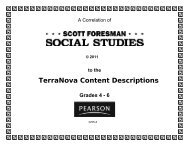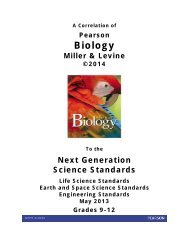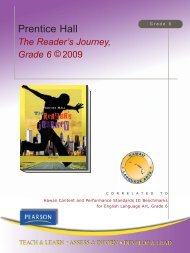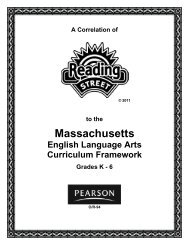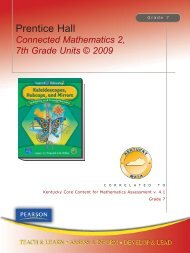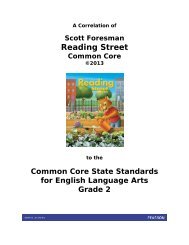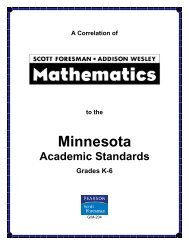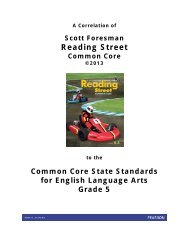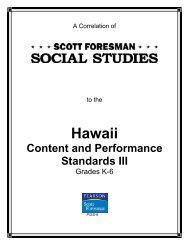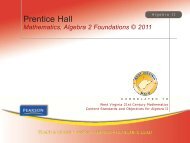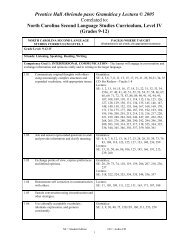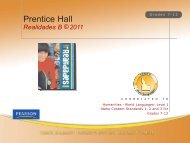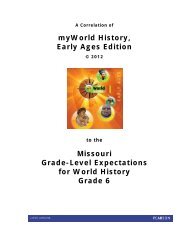Miller & Levine Biology: Foundation Edition - Pearson
Miller & Levine Biology: Foundation Edition - Pearson
Miller & Levine Biology: Foundation Edition - Pearson
Create successful ePaper yourself
Turn your PDF publications into a flip-book with our unique Google optimized e-Paper software.
A Correlation of<strong>Miller</strong> & <strong>Levine</strong> <strong>Biology</strong>, <strong>Foundation</strong> <strong>Edition</strong>, ©2014to the Next Generation Science Standards, May 2013Grades 9-12HS-LS4-5. Evaluate the evidence supporting claims that changes in environmental conditions may result in: (1) increases inthe number of individuals of some species, (2) the emergence of new species over time, and (3) the extinction of otherspecies. [Clarification Statement: Emphasis is on determining cause and effect relationships for how changes to the environment such as deforestation, fishing, application offertilizers, drought, flood, and the rate of change of the environment affect distribution or disappearance of traits in species.]MILLER & LEVINE BIOLOGY, <strong>Foundation</strong> <strong>Edition</strong>: In Lesson 17.3 (pp. 414–416), students learn how different types of isolation can leadto the formation of new species. Lesson 19.2 (pp. 456–457) discusses the processes that influence whether species survive or becomeextinct.Students evaluate the evidence for claims that environmental conditions may result in speciation or extinction: Students exploreevidence that climate change is causing a genetic decline in alpine chipmunks (pp. 377a–377b). Students use evidence to suggest anexplanation for the Permian mass extinction (Chapter Mystery, Q2, p. 474).HS-LS4-6. Create or revise a simulation to test a solution to mitigate adverse impacts of human activity on biodiversity.*[Clarification Statement: Emphasis is on designing solutions for a proposed problem related to threatened or endangered species, or to genetic variation of organisms for multiplespecies.]MILLER & LEVINE BIOLOGY, <strong>Foundation</strong> <strong>Edition</strong>: Lesson 6.3 (pp. 138–142) discusses the value of biodiversity, threats to biodiversity,and ways to conserve biodiversity. The Unit 2 Project, Disappearing Mussels! (pp. 53a–53b), asks students to recommend ways to preventthe decline of marine populations.The performance expectations above were developed using the following elements from the NRC document A Framework for K-12 Science Education:Science and Engineering Practices Disciplinary Core IdeasAnalyzing and Interpreting DataLS4.A: Evidence of Common Ancestry and DiversityAnalyzing data in 9–12 builds on K–8 experiences and •Genetic information provides evidence of evolution.progresses to introducing more detailed statisticalDNA sequences vary among species, but there are manyanalysis, the comparison of data sets for consistency, and overlaps; in fact, the ongoing branching that producesthe use of models to generate and analyze data.multiple lines of descent can be inferred by comparing the•Apply concepts of statistics and probability (including DNA sequences of different organisms. Such informationdetermining function fits to data, slope, intercept, and is also derivable from the similarities and differences incorrelation coefficient for linear fits) to scientific and amino acid sequences and from anatomical andengineering questions and problems, using digital tools embryological evidence. (HS-LS4-1)when feasible. (HS-LS4-3)SE: Inquiry into Scientific Thinking (p. 492)TE: Active Reading (p. 397)LMB: Mycorrhizae and Tree Height (pp. 287–288)Using Mathematics and Computational ThinkingMathematical and computational thinking in 9-12 buildson K-8 experiences and progresses to using algebraicthinking and analysis, a range of linear and nonlinearfunctions including trigonometric functions, exponentialsand logarithms, and computational tools for statisticalanalysis to analyze, represent, and model data. Simplecomputational simulations are created and used based onmathematical models of basic assumptions.•Create or revise a simulation of a phenomenon,designed device, process, or system. (HS-LS4-6)Constructing Explanations and Designing SolutionsConstructing explanations and designing solutions in 9–12builds on K–8 experiences and progresses to explanationsand designs that are supported by multiple andindependent student-generated sources of evidenceconsistent with scientific ideas, principles, and theories.•Construct an explanation based on valid and reliableevidence obtained from a variety of sources (includingstudents’ own investigations, models, theories,simulations, peer review) and the assumption thattheories and laws that describe the natural world operatetoday as they did in the past and will continue to do so inthe future. (HS-LS4-2),(HS-LS4-4)SE: Q8 (p. 397); Q2 (p. 545); Q10 (p. 599)SE/TE: Genetics and Molecular <strong>Biology</strong> (p.395); Genetics Joins Evolutionary Theory (p.406); Molecular Evolution (pp. 417–419)LS4.B: Natural Selection•Natural selection occurs only if there is both (1)variation in the genetic information between organisms ina population and (2) variation in the expression of thatgenetic information—that is, trait variation—that leads todifferences in performance among individuals. (HS-LS4-2),(HS-LS4-3)SE/TE: How Natural Selection Works (pp.409–410)•The traits that positively affect survival are more likelyto be reproduced, and thus are more common in thepopulation. (HS-LS4-3)SE/TE: Gene Pools (p. 406); NaturalSelection on Single-Gene Traits (p. 409)Crosscutting ConceptsPatterns•Different patterns may be observed at each of thescales at which a system is studied and can provideevidence for causality in explanations of phenomena. (HS-LS4-1),(HS-LS4-3)SE: Build Connections (p. 389); A Range ofPhenotypes graphs (p. 408); Use ScienceGraphics (p. 424); Q2 (p. 471)LMB: Molecular Homology in Hoxc8 (pp.275–276)Cause and Effect•Empirical evidence is required to differentiate betweencause and correlation and make claims about specificcauses and effects. (HS-LS4-2),(HS-LS4-4),(HS-LS4-5),(HS-LS4-6)SE: Build Connections (p. 394); Survival ofthe Fittest and Beak Size graph (p. 397)TE: Transfer Performance Task (p. 470)LMB: Extinctions Through Time (pp. 281–282)<strong>Biology</strong>.com: Chapter 16 STEM activity,Bird Beaks; Chapter 19 Data Analysis,Extinctions---------------------------------------------Connections to Nature of ScienceScientific Knowledge Assumes an Order andConsistency in Natural Systems•Scientific knowledge is based on the assumption thatnatural laws operate today as they did in the past andthey will continue to do so in the future. (HS-LS4-1),(HS-LS4-4)SE: An Ancient Changing Earth (pp. 384–385)SE = Student <strong>Edition</strong>; TE = Teacher’s <strong>Edition</strong>; LMB = Lab Manual B 16



